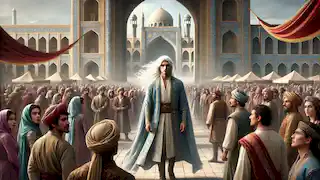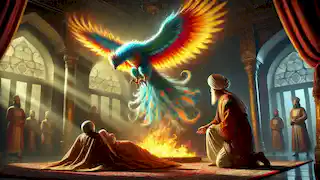Once upon a time in the ancient land of Persia, a kingdom of vast deserts, high mountains, and grand palaces, a tale of mystery and magic unfolded. This was a time when kings ruled with wisdom and valor, and mythical creatures roamed the skies and forests. Among the many legends that have passed through the generations, one of the most celebrated is the tale of the Simurgh and the Baby Zal.
This story begins in the kingdom of Sistan, where a noble warrior named Sam lived. Sam was one of the greatest warriors of his time, a man renowned for his strength, bravery, and loyalty to his king. He was the beloved son of the ruling family, a man who commanded respect on the battlefield and was admired for his just rule over the lands he governed. But Sam, despite his accomplishments, had one deep yearning — the desire for an heir, a son who would carry on his name and lineage. For many years, Sam and his wife prayed for a child, hoping the gods would bless them with a son.
One fateful night, Sam’s prayers were answered. His wife gave birth to a beautiful baby boy, but to their great dismay, the child was born with a striking and unusual feature: his hair was as white as snow. In ancient Persian culture, this was seen as a bad omen, a sign of misfortune. Though the baby was healthy and vibrant, Sam feared the judgment of his people. He believed the white-haired child was a curse from the gods, and that his son, despite his innocence, would bring sorrow to his family.
Haunted by his fear, Sam made a heartbreaking decision. He commanded that the child, whom they named Zal, be abandoned on the slopes of the Alborz Mountains, far from the kingdom. The order was carried out, and the newborn was left in the wilderness, exposed to the elements, where no human could survive for long.
As the days passed, the baby Zal lay in the cold and rugged terrain, crying out in hunger and desperation. But fate had a different plan for him, and the gods of old had not truly forsaken him.
It was on a night when the full moon illuminated the towering mountains that the great Simurgh, a mythical bird of enormous size and great wisdom, heard the cries of the abandoned child. The Simurgh, whose feathers were said to contain all the colors of the universe, was no ordinary creature. She was as old as the earth itself, a protector of the natural world and a keeper of ancient knowledge. When the Simurgh soared through the sky, she could see all that transpired below her, and her heart was moved by the plight of the helpless infant.
The Simurgh descended from the heavens, her vast wings casting a shadow over the land as she flew toward the spot where Zal lay. Upon finding the child, the Simurgh, with her deep compassion, gently picked him up with her talons and carried him back to her nest, which was perched high in the mountains, far from the reach of any human.
{{{_01}}}
In the nest of the Simurgh, among the clouds and cliffs, Zal was nurtured. The Simurgh became his protector, his guardian, and in many ways, his mother. She fed him from the fruits of the earth and the creatures of the mountains. Under her care, Zal grew strong and wise, learning not just survival but the secrets of nature, the cycles of the world, and the deep wisdom of the ages. The Simurgh, with her endless knowledge, taught him things no human could have known, filling his heart with understanding and compassion.
Years passed, and Zal grew into a young man, tall and handsome, with his distinctive white hair flowing down his back. Though he had lived his life with the Simurgh and had grown to love her as a mother, the call of humanity still stirred within him. He often wondered about the world below, the world of men, and the kingdom from which he had been cast out. As much as the Simurgh’s nest had become his home, he knew that his destiny was tied to the people of his birth.
One day, the Simurgh sensed the longing in Zal’s heart. She knew that the time had come for him to return to the world of men, to reclaim his place among his people. With great sadness, she spoke to him of his origins, revealing the truth of how he came to be abandoned in the mountains and why his father had made that choice. Though the news was painful, Zal understood. He knew that he must forgive his father and return, not with anger, but with the wisdom he had gained from the Simurgh.
The Simurgh, before sending Zal on his journey, gave him three of her magnificent feathers. "If ever you find yourself in danger," she said, "burn one of these feathers, and I will come to your aid." With a heavy heart, Zal bid farewell to the great bird who had been his guardian, his teacher, and his mother. He descended the mountain, making his way back to the world of men.

Upon reaching the kingdom of Sistan, Zal’s arrival caused a stir. His striking appearance, especially his flowing white hair, set him apart, but the people were captivated by his strength and grace. News of his return quickly reached the ears of his father, Sam. The warrior, who had long regretted his decision to abandon his son, was overwhelmed with guilt and sorrow when he heard that the white-haired child he had left to die in the mountains had not only survived but had grown into a noble and wise young man.
Sam, filled with remorse, rushed to meet his son. When they finally came face to face, the emotions between them were overwhelming. Sam knelt before Zal, begging for his forgiveness. Zal, with the wisdom and compassion he had learned from the Simurgh, lifted his father up and forgave him. He understood that fear had driven his father’s actions, and he harbored no resentment. Instead, he embraced Sam, and together, they wept for the years they had lost.
Zal’s return to Sistan was celebrated by the people, and he was welcomed back as the rightful heir to his father’s throne. Under his leadership, the kingdom flourished, for Zal ruled with the wisdom of the Simurgh and the strength of a warrior. His name became synonymous with justice, courage, and compassion.
But the story of Zal and the Simurgh did not end with his return to Sistan. His adventures continued, and one of the most significant moments of his life came when he met Rudabeh, the daughter of Mehrab, the ruler of Kabul. Rudabeh was renowned for her beauty, intelligence, and grace. When Zal saw her for the first time, he was instantly captivated by her, and she, too, fell in love with him. However, their love was fraught with challenges.
Rudabeh's family descended from Zahhak, a tyrant of ancient times, and their union was considered problematic by the elders of Sistan. But Zal, driven by his love and guided by the wisdom of the Simurgh, pursued Rudabeh's hand in marriage with determination. The elders of the court were against the union, fearing the consequences of aligning their bloodline with that of Zahhak, but Zal, undeterred, sought the advice of his father, Sam, and the blessing of the kingdom’s ruler, King Manuchehr.
Sam, who had learned from his past mistakes, supported his son. He recognized the strength of Zal’s love for Rudabeh and believed that their union could bring peace between their two families. However, the king’s approval was still necessary. To ensure their marriage would not bring misfortune upon the kingdom, Sam traveled to meet King Manuchehr himself, explaining the virtues of his son and the potential for a peaceful alliance.

The king, after much deliberation, agreed to the marriage, seeing the wisdom in Sam’s words and the potential for unity between the two regions. With the king’s blessing, Zal and Rudabeh were married in a grand ceremony that was celebrated across the lands of Persia. The love between Zal and Rudabeh was deep and genuine, and their union became a symbol of reconciliation between once-feuding families.
In time, Zal and Rudabeh had a son, a child destined for greatness. His name was Rostam, and he would become one of the most legendary heroes of Persian mythology, whose deeds and battles would be told for centuries to come. But even as Zal grew older, he never forgot the Simurgh, who had saved his life and guided him toward his destiny.
There came a time when Zal needed the Simurgh once more. During the birth of his son Rostam, Rudabeh faced great difficulty. The labor was long and perilous, and it seemed as though both mother and child were at risk of dying. Desperate, Zal remembered the feathers given to him by the Simurgh. Without hesitation, he took one of the feathers and cast it into the fire, summoning the great bird from the heavens.

The Simurgh appeared in all her glory, descending once more from the skies to aid her beloved Zal. With her ancient wisdom, she instructed Zal on how to perform a procedure that would save both Rudabeh and the child. Under her guidance, Zal carefully made an incision and helped deliver his son, Rostam, safely into the world. It was through the Simurgh’s intervention that both mother and child survived, and Zal’s gratitude to the great bird deepened even further.
Thus, the story of Zal and the Simurgh became one of the most cherished legends in Persian mythology. It is a tale of love, forgiveness, wisdom, and the bond between man and nature. The
Simurgh, a creature of immense power and knowledge, played a crucial role in shaping the destiny of one of Persia’s greatest heroes, and her legacy lived on in the hearts of all who heard the tale.
Zal’s life, from his abandonment in the mountains to his rule over Sistan and his love for Rudabeh, was a journey guided by fate, but also by the kindness of a mythical creature whose wisdom transcended the mortal realm. The Simurgh’s feathers, her gift to Zal, remained a symbol of her enduring love and protection, and they served as a reminder that even in the darkest of times, there is always hope.
And so, the story of the Simurgh and the baby Zal endures, a timeless narrative of redemption and the profound connection between the human and the divine.

















